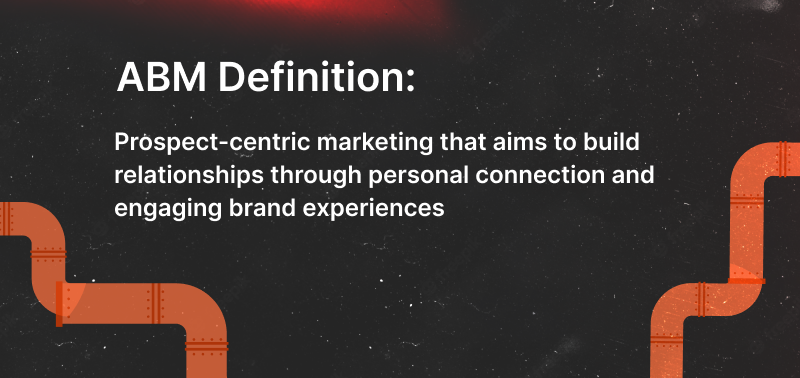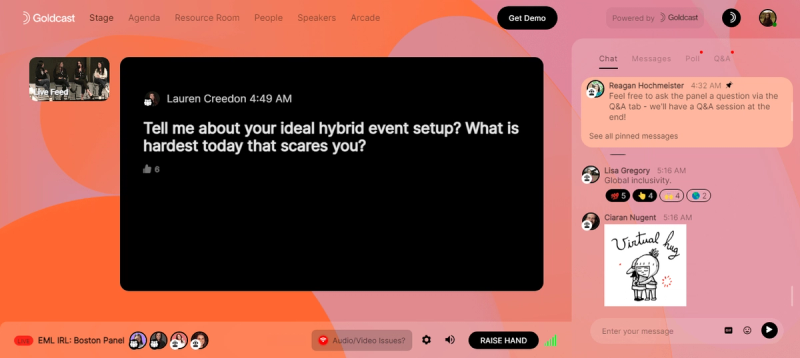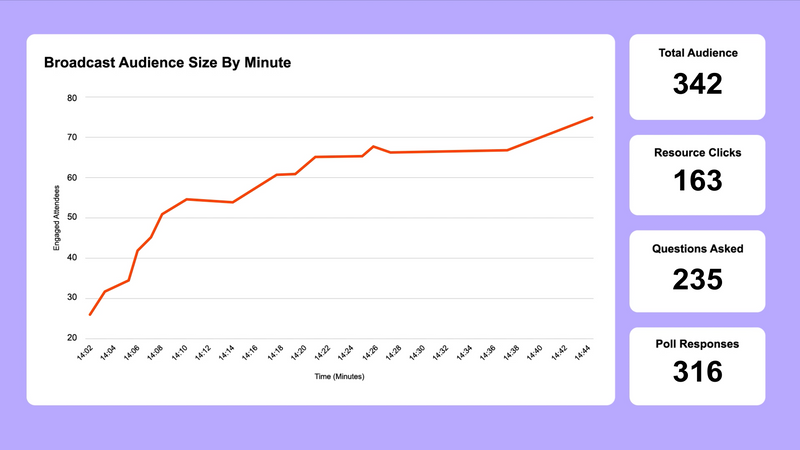Ready to Drive More Pipeline? Here’s How to Run Your Digital Field Events

Table of Contents
Maximize Your Marketing ROI
Join 10,000 other marketers already getting the best tips on running engaging events that boost pipeline and create raving fans.
Over the last few years, digital field events have earned a central position in every high-performance account-based marketing (ABM) strategy. And the results speak for themselves.
While in-person events will always have a place in our calendars (and our hearts 🧡), modern event marketers also need to ensure their digital events are positioned to increase and accelerate the revenue pipeline.
But at a time when attendee expectations are higher than ever, that’s not always easy to do. Recreating the in-person experience digitally isn’t as simple as setting up a webcam, micing up some speakers, and letting them loose with a slideshow.
To pull off a digital field event that moves the needle on both experience and revenue, there are some key steps you can't afford to skip.
Here’s what we’ll cover:
- What is a digital field event?
- What are the real pros and cons of digital field events?
- 5 steps to planning a digital field event
What exactly is a digital field event? A look back at how we got here
Similar to an in-person field marketing event, a digital field event is a form of experiential marketing that places face-to-face relationship building at the forefront. Rather than limiting prospect and customer interactions to physical events, digital field events help ABM marketers reach larger audiences while using deeper data insights to measure and replicate their success.
It’s important to note that when it comes to both ABM and digital field events, definitions will vary based on a company’s marketing goals and team structure when it comes to both ABM and digital field events.
Here at Goldcast, digital field events follow the same setup as their in-person counterparts: intimate gatherings with a group of highly targeted prospects who are all linked via their industry, needs, or challenges.
In fact, the only difference is that digital events take place in a fully or partially remote environment rather than the proverbial ‘field.’ Whether it’s in-person, digital, or hybrid, the ultimate aim of field events today remains the same:
To accelerate the pipeline and close deals.
But to really understand why digital field events are important, we have to take a closer look at how B2B event marketing has evolved.

A brief history of B2B events
From the annual gala dinners of the old to the new era of B2B events, field marketing has undergone a major overhaul in recent years.
In the past, the aim was simple: shake some hands, swap some business cards, and hope you make an impact. But as the dawn of the revenue marketer emerged, hand-in-hand with a global pandemic, the events scene underwent a rapid transformation.
Prior to this moment, in-person events could be judged by how many people showed up and how good of a time you had. But the field events of the future?
Those would need to deliver results beyond registration and attendance rates, prioritizing metrics that can be attributed to revenue.
With the rise of digital and hybrid, events have gone from a once-annual affair to the everyday mouthpiece for growing brands across the globe. And after years of guesswork, their impact on pipeline is much more measurable.
Looking to the future, our research has found that some 75% of companies say large scale events are becoming less common, and 73% predict hybrid events will become the most common event format.
With increasing pressure on budgets, travel policies, and bandwidth, digital events offer a clear solution for many modern B2B brands.
The next generation of event marketing is going to become more focused. No longer will we hear ‘Join 10,000 people just like you!’. Instead, we will hear calls for an experience that feels exclusive, personalized, and ‘me’ focused.” — Connor DeLaney, Director of Membership, IMPACT
What are the real pros and cons of digital field events?
Following the same high-touch concept as their in-person counterparts, digital field events help amplify your ABM strategy by providing quality engagement opportunities with greater reach, convenience, and data insights.
Which means they also have a much more prominent role in driving pipeline.
Here are some of the top benefits digital field events can deliver:
✅ Increased ROI — from venue to staffing, digital events cost less across the board
✅ Improved accessibility — eliminating cost of travel and increasing inclusivity
✅ Global reach — removing geographical barriers and widening the prospect base
✅ Scalability — via digital event tech for easy-to-replicate branded events
✅ Less on-the-day pressure — by pre-recording plug-and-play content
✅ Deeper data — insights at both the event and individual attendee level
✅ Greater convenience — through virtual, in-person, and hybrid options
✅ Better sales opportunities — facilitating 1:1 sales conversations and demos
✅ Evergreen content — that can be repurposed and leveraged across channels
Clearly, there are some strong advantages to digital field events. But there are a few drawbacks to watch out for too.
Let’s take a look at the potential downside of digital field events:
❌ Fewer on-the-spot networking opportunities — nothing beats an in-person handshake, but with private rooms, P2P messaging and more, digital events can finally come close
❌ Not enough ‘wow’ factor — digital events often lack the energy of in-person, but with the right production and engagement tools, your virtual event can still be a show-stopper
❌ Higher risk of no-shows — no show rates are understandably higher for digital, look for tools that provide seamless registration, automated reminders, and easy on-the-day access
❌ Tech failures = game over — glitchy connections and muted mic mishaps happen, always plan a dry run and have a backup plan in place before the big day
❌ Limited sponsorship revenue — reduced branding opportunities can lead to less revenue generated through digital field events
❌ A battle for attendee attention — sitting behind a screen is hard work, but if you nail the content, platform, and engagement, you can increase time spent in the event
If you play them right, there are more pros than cons when it comes to digital field events.
Not only that, by creating a forward-looking digital events strategy now, you may end up several steps ahead in the future.
In fact, our research has also shown that two out of three companies are cutting travel budgets, while 80% are encouraging employees to attend more virtual and hybrid events instead of in-person.
And it’s not just companies who are leveraging the benefits of digital field events. At the individual level, event attendees stated they are 81% more likely to commit to a hybrid event due to the flexible attendance options.
Between company policies, budget constraints, and attendee preferences — digital and hybrid events are clearly the future. But again, it all comes down to how you plan and execute them.

5 steps to boosting pipeline with digital field events
Step 1. Identify target accounts
As an experienced field marketer, we’re likely preaching to the choir when we tell you to align with sales on your target event audiences. But since this is an ongoing issue in the world of ABM, it bears repeating.
A simple way to approach sales and marketing alignment for your digital field events is to:
- Work with sales to pinpoint key accounts — top prospects, hold-outs, upsell opportunities, etc.
- Stay mindful of list size to determine whether you’ll need an intimate gathering or a larger-scale event
- Ask sales for insights on other inbound or outbound leads that could generate quick wins with minimal investment (e.g., a longtail webinar providing deeper insights on a commonly discussed topic)
- To maximize event ROI on higher-intent accounts, ask sales to invite only those where an existing opportunity is in progress
🔥 Hot Tip: Here’s how we source and prioritize field event targets at Goldcast:
- We have a target list of ~300 accounts we are actively connecting with as part of our ABM efforts. These ~300 accounts have been divided and assigned to reps and BDRs.
- In addition to the ABM target list, the reps have accounts they may be working from other inbound or outbound efforts. For our field events, we ask reps to only invite accounts that are existing opportunities or an account they’ve been actively pursuing and hope can become an opportunity after attending our event.
- Depending on the budget and activity, we will cap the event (usually between 15-30 people). If there is very limited capacity, we instruct the reps to prioritize the focus on the existing opportunities that are most likely to move forward.
Step 2. Create your digital event concept
To generate as much pipeline as possible through your digital field events, you’ll need an acute understanding of where your prospects are within the purchasing journey, where they’re looking to go next, and how your product can get them there.
To achieve that, you’ll need to lean into the power of targeted, invite-only events to personalize the experience. And for that, these two approaches are great ways to go:
The intimate event
With 75% of companies and attendees reporting that large-scale events are becoming less common, an exclusive VIP event is a great alternative.
Pinpoint the common interests among your target accounts — think: industry, challenges, roles, requirements, etc. — and curate an event schedule that addresses their needs and ensures they feel understood on a personal level.
For example, an intimate digital field event could take the format of a:
- Roundtable
- Fireside chat
- Customer case study
- Custom product demo
- Masterclass
- Q&A

The experiential event
If the name of the game is nurturing prospect relationships to drive future pipeline, replacing the overused hard sell with a white glove digital event experience is an excellent approach.
Here are some formats to consider:
- VIP networking events
- Virtual award ceremonies
- Wine-tastings
- Cooking classes
- Mixology sessions
- Coffee painting
- Candle making
- Live music sets
- Event gamification
- And more
Whichever format you choose, go back to step one to make sure both marketing and sales are aligned on who your event serves and why it matters.

🔥 Hot tip: Looking for event inspiration?
We’ve been hosting digital field events since 2020, so we know how daunting it can be to come up with new ideas and vet new vendors. The good news for you is that we’ve done all the legwork! From virtual wine tastings to digital DJ happy hours, check out these preferred event partners.
Step 3. Build your event promotion plan
When it comes to event marketing, you won’t be shocked to hear that getting people to show up is a pretty big deal. With only 27% of B2B professionals feeling confident in generating registrations and attendance for digital events, this is one area we could all use a little help with.
To keep your digital event attendance high, create a clear plan to promote it. To start, try these proven event promotion tips:
- For highly targeted events, email is your friend. Try a 1:few email from marketing, plus a 1:1 email from sales, to let prospects know they’re at the top of your VIP invite list.
- Add a relevant GIF or celebrity cameo video to help your email stand out.
- Entice prospects with a session snippet from one of your pre-recorded speakers.
- Gamify your outreach with quizzes and interactive games to give potential attendees a taste of what’s coming.
- Offer up extra special VIP swag for folks who attend on the day.
While real success with digital field events is about much more than attendance rates, the fact remains: The lower your attendance rate, the lower your potential ROI.
When the time comes to talk about future event budgets, the last thing you want is sluggish buy-in. A clear event promotion plan can help make signoff a breeze.
Throughout our campaign, memes or GIFs are embedded into the body of our emails to hook the reader in. The language used is crisp and to-the-point while relevant to the reader. This strategy propelled our email open rate by 32%.” — Padmaja Santhanam, Partner & Growth Manager at FirstPrinciples
Step 4. Host your event! 🎉
For an ABM strategy to really work, your sales team can’t just be there for the pre-party prep and post-event clean-up. They need to show up and be the familiar face prospects are looking for.
Find an opportunity within your digital event agenda to facilitate seamless (non-salesy!) 1:1 time between sales and attendees.
Keep in mind, while the right sales convos are crucial for generating more pipeline, the rest of your event needs to elevate the brand experience to impress your key accounts.
Here are some of the key digital event engagement levers for increased interaction:
- Event chat
- Live polls
- Video Q&A
- Ice-breakers
- Virtual event games
- Shout-outs & scoreboards
- Booths & rooms
- Branding
- Swag & gifting
- Social media
- Event content
- Event data

Step 5. Post-event follow-up and reporting
An ABM approach to digital event marketing doesn’t stop when the laptop lid closes. In fact, that’s when the real work begins.
First, you’ll need to run the numbers. With the help of a data-driven event platform, your post-event analysis can go way beyond registrations to get to the pipeline-related stats your executive team wants to see, including:
- Event engagement scores
- # of MQLs
- # of SQLs
- Pipeline creation & velocity
- Attendee satisfaction scores
- Closed-won revenue
- Return on investment
But while having the data to score leads and prove event ROI is great for keeping internal buy-in strong, your digital event data is even more crucial when it comes to delivering ultra-personalized sales follow-ups.
With direct CRM-to-platform integrations, your attendee-level event data can flow seamlessly into contact records to include:
- Time in breakout rooms
- Sessions attended
- Content downloaded
- Polls answered (and how they answered)
- Questions asked
- # of clicks
- Booths visited
- Demos watched
- Videos viewed
- Messages sent
- And more
With the right insight, sales can easily tailor post-event outreach to speak directly to the prospect’s journey — for example:
- ‘I saw you downloaded this session, would you like some more info on that?’
- ‘I noticed you voted for this answer in the poll — can we help with that?’
- ‘You attended this session — it was great, right? Would you like to discuss further?’
With follow-up this personal, prospects instantly know this isn’t ‘just another mail merge.’ Instead, they’re more likely to feel valued as a trusted member of your brand community.

Account-based marketing + digital field events = Pipeline perfection 🏆
If you’re ready to take the ABM wheel and drive increased pipeline, digital field events are here to help. But for digital events to really reach their full potential, it’s going to take a village (or at least a team member or two).
At Goldcast, our event platform is purpose-built for B2B marketers looking to leverage the power of digital events for a high-ROI ABM strategy.
Because the new era of marketing is here. And the brands who take action to deliver on their customers’ needs today will be ahead of the game tomorrow.

Transform Your Video Marketing with AI
Stay In Touch
Platform
Resources
© 2025 Copyright Goldcast, Inc. All rights reserved.





 Upcoming Events
Upcoming Events Event Series
Event Series On-Demand Events
On-Demand Events

